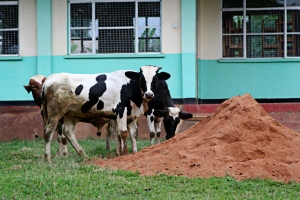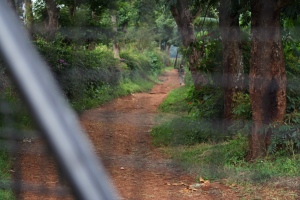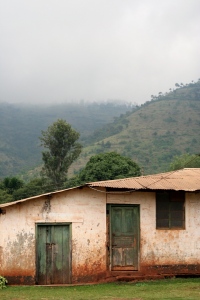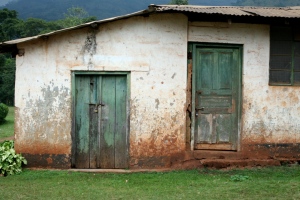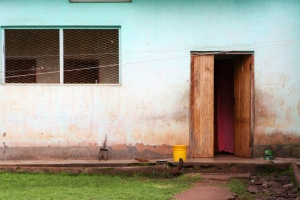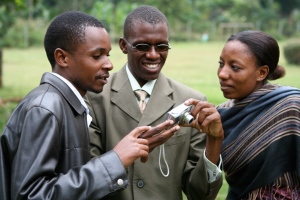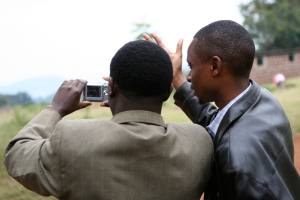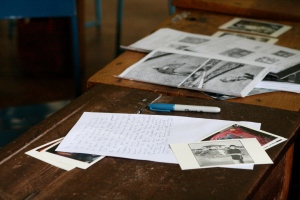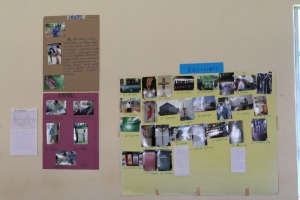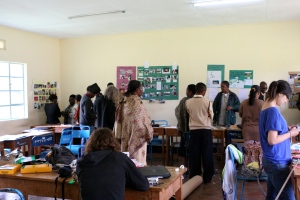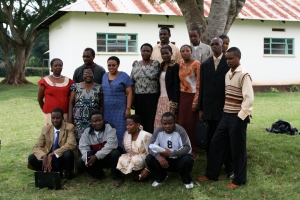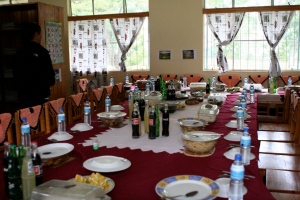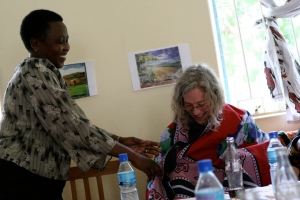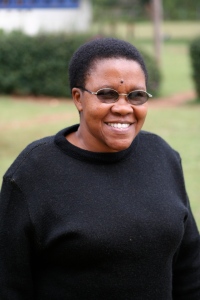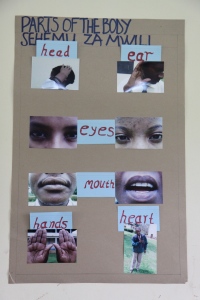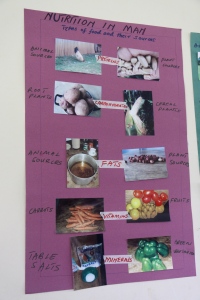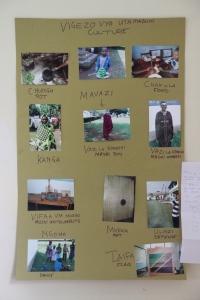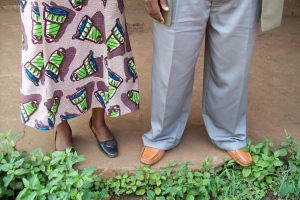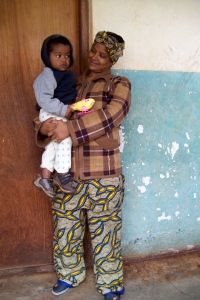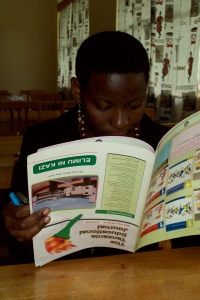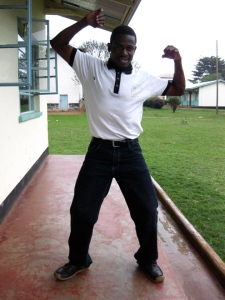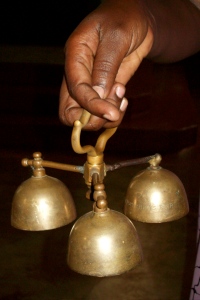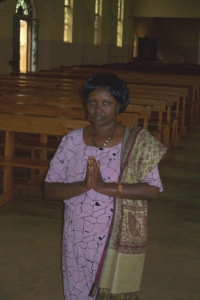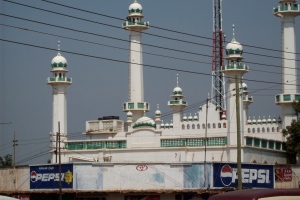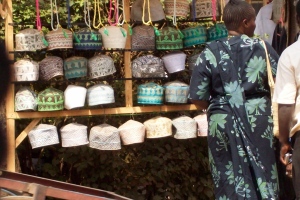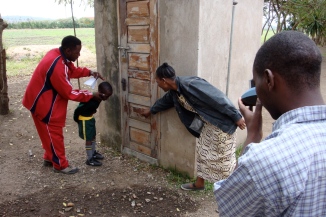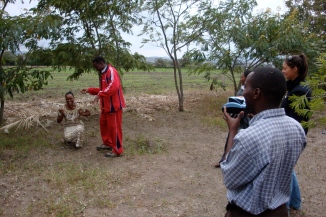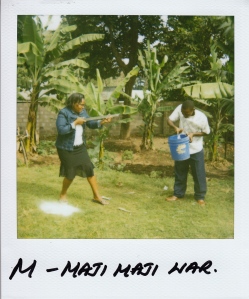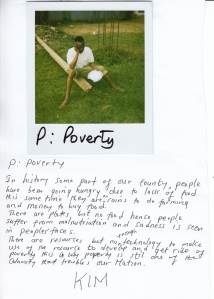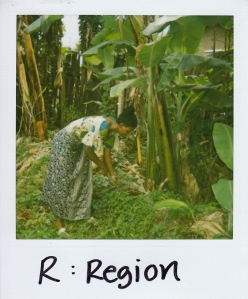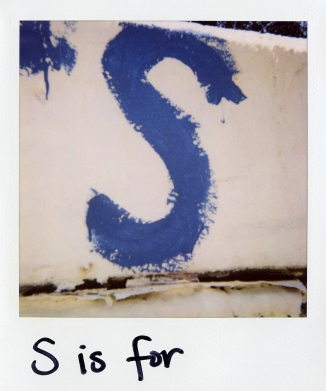The picture I have is of a group of students at Uhuru School linking together to form a strand of DNA. Working with the biology and chemistry teachers in a workshop earlier that day, we brainstormed some of the harder concepts of those subjects and decided that an understanding of DNA was something many of their students lacked. So the teachers began sketching the layout and organization of DNA, including base pairs, hydrogen bonds, sugars, and phosphate groups. But as soon as one teacher began sketching, another snatched the pencil out of her hand and tried to diagram it in a different configuration. Debate continued, as ten teachers trained in biology and chemistry struggled to correctly sketch all the components of DNA. Eventually, one of the teachers slid the paper over to me, and asked if they had done it correctly. I was taken aback, as if suddenly they had changed into a group of students seeking reinforcement from their teacher. I did my best to reorganize the diagram, moving some molecules here and there until it looked more or less like what I remember from textbooks, though as I drew they became insistent that my drawing was the correct one, and suddenly the confusion over DNA had ceased. It almost frightened me how willing they were to accept whatever solution I provided them, regardless of my qualification. It really rang home how important well-trained teachers are. Whether or not I had the correct answer for DNA didn’t seem to matter to my “students”, for my expertise was assumed. On the one hand this reverence to those with knowledge is conducive to learning, while on the other hand, if not careful, this reverence can lead students down a path of misinformation. Despite the confusion over DNA, our group moved on and successfully capture the concept in photographs. The teachers collected a group of students, probably twenty in total, and began lining them up in groups: bases, hydrogens, sugars, and phosphates. From there they began joining student’s hands to form bonds, and eventually had what looked like from above a great example of the organizational structure of DNA.
Category Archives: Workshops
learning to see beyond expectations, a photo reflection by Kirstie Jeffreys

This picture was during my first LTP experience in Tanzania. We went into Swift School to hold a teacher workshop. I was paired with Nate and given the topic of math which I was uneasy about as it were. I remembered back to my first day in the Literacy Through Photography class in Durham North Carolina and how I proclaimed to Katie Hyde that, “I think LTP works with almost ANY subject, of course except math.” As I progressed through the class I found that boy was I wrong. After reviewing countless projects and visual aids that oriented photography into a math curricula I was convinced. Not only were the kids learning math, they were involved in a fun interactive way with a subject I tended to avoid. Perhaps if I had such an experience early on I would’ve looked at mathematics in a different light.
We were assigned the topic of angles. After discussing different types of angles found in nature and way to display these visually we set off to work. We snapped photos of obvious images: corners, doors, windows, a protractor, etc. I found these to be rather bland and unengaging. Then as we were walking back to the class room we saw this little girl swinging on a swing set but not in an organic way that one would imagine. The children weren’t using the seats that were wrapped around the top of the set. I asked why no one was using the set the right way to which Mohammed responded, “The swing set was constructed wrong and is unsafe for them to use.” This made me incredibly sad yet also helped me realize something that pervades their culture in many forms. Just because something is broken does not mean it cannot be enjoyed. In Africa they make the very most out of every resource available to them regardless of circumstance. We constantly see locals in every type of shirt from the clothing drives including Old Navy, Greek Life shirts, various college names. The value placed on use far surpasses that of a label or name brand. Swift did not remove the swing set nor deem it defective, the children just found another way to enjoy the toy and made lemonade out of lemons. In the words of Dave Matthews, Africa “made the best of what’s around.”
N is for Neo-Colonialism, a photo reflection by Anne Rhett

They say a picture is worth a thousand words.
What they fail to mention is that in some cases, as that of the Polaroid above, one word can be more than enough. One too many, even.
It all started at the Themi Secondary school LTP teacher workshop. Our history-themed alphabet project was going swimmingly. It was all click-flash, business-as-usual until letter “N” was upon us…
Suddenly, a bit of commotion arose from the teachers’ circle, in Kiswahili of course. Then came the wild gesticulation in my direction. Okay. Then there was ambush- I was dragged into the frame, flanked by two giggling Themi teachers.
I remained calm.
For better or worse, it appeared I was essential to this photo-but why, oh why? I glanced quickly at their list.
N is for…Nationalism?
Alright, Tanzanian Nationalism…I can get on board with that! I thought, embracing them with an enthusiasm I typically reserve for the Christmas card and flashing a megawatt grin to match.
But nationalism our “N” was not, something I discovered with sinking stomach during the labeling phase of the project, as I watched that N be followed by many highly unanticipated letters.
Turns out I had unwittingly situated myself in the center of the image intended to represent NEO-COLONIALISM. There I was, in all my fair-skinned, beaming glory—the newly minted posterchild for legacies of oppression, exploitation, self-service and condescension –all the things from which we volunteers try so hard to disassociate ourselves.
To all outside eyes, this would indicate a huge DukeEngage Academy FAIL. Chloe would not be happy about this, I thought.
Later on, when the photographer explained her understanding of neocolonialism, it was clear that she meant to convey none of the irony, none of the insult that I had mentally extracted. All she meant to do was depict the new, friendlier type of relationships that occur between native Africans and those of European descent.
But despite her innocent intentions, the glaring label- or mislabel- remained.
And the real kicker was this: In many ways, I was not sure how far from accurate the caption truly was.
Many times over the course of this trip I have wondered how our “service” appears to those we are “serving.” We interrupt normal school schedules to introduce our concepts, methods we are sure they will benefit from.
We criticize their way of doing things- their system of education is too rote, too regimented, not free, creative or process-oriented enough. And, despite the pains we take to emphasize our commitment to partnership, collaboration and enhancement, the subtext is always there: our way is better. They can learn from us.
I can only hope that the legacy we leave here will inspire 999 other words.
Working with Mandaka Teachers’ College, a post by Kaitlin Rogers
After three weeks working in and getting acquainted with Arusha we retreated to Mandaka Teacher’s College for a five-day LTP workshop. Mandaka’s campus is beautiful, tucked away amidst cornfields and farmland at the base of Mt. Kilimanjaro. We arrived on Monday afternoon, and the campus was quiet, and Mama Mchoma, the principal, was the first to warmly welcome us. After signing the guest book we quickly settled into our dorm rooms and met with the teachers for lunch.
This workshop was for the teachers of Mandaka Teachers College. We hoped to familiarize them with the methodology and utility of “Learning Through Photographs” so that they can introduce LTP in their classrooms as a tool for their students to use in their future classrooms. It is exciting to consider LTP’s potential if these teachers present LTP to their students each year and those students graduate to teach all throughout Tanzania.
On Monday we simply met with the teachers and briefly introduced the program, and on Tuesday morning we dove into the workshop with a reading photographs exercise and the first shooting assignment. The teachers seemed eager to lean about LTP; however, at first it was slightly challenging to communicate the unique mentality. With LTP, for example, there is often no correct answer. In fact, much of LTP is about noticing and appreciating different answers and ideas. This is often hard for teachers here to grasp because it is so different from their traditional approach. As the workshop progressed, however, the teachers slowly grew more comfortable with LTP. Together we worked through many more reading photograph and writing exercises and completed the “Best Part of Me” project and four subject-themed alphabet projects.
On Thursday we divided the teachers by subject and worked with each teacher individually to design a LTP project that would fit specifically into their curriculum. This one-on-one time was a great way to make sure each teacher understood that it is possible to incorporate LTP in any curriculum. It was also a useful way to gage each teacher’s understanding of LTP, which turned out to be quite impressive. By the final day each teacher had developed a lesson plan and completed the project. The walls of the workshop room were covered with colorful visual aids, and the teachers took turns standing before the group to present their work. Working individually to create lesson plans turned out to be extremely effective, and we look forward to hearing if the teachers follow through with the projects in their classrooms.
Thank you, Mama Mchoma and teachers and staff of Mandaka Teacher’s College for so graciously hosting us for five days. We really enjoyed working with and learning from you.
KAITLIN’S PHOTOGRAPHS FROM MANDAKA
Integrating photographs into the curriculum
The teaching staff at Mandaka Teachers College designed their own LTP projects by choosing a particular area of their syllabus-whether within the discipline of psychology, geography or history- and creating photographs to explore and illustrate concepts. They made wall charts to use in their teaching and created a plan for how to use similar activities (with photographs and writing) in their classes with teachers in training.
Mandaka teachers also explored several topics (gender, religion, HIV and home economics) within the area of LIFESKILLS.
The following pictures were made to illustrate concepts related to GENDER.
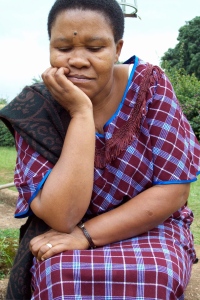
Concept: PAIN
The following pictures were made as an exploration of the topic of HIV.
 [/caption]
[/caption]
Concept: COUNSELING
The following pictures relate to the theme of RELIGION.
Teacher Workshop Reflection, by Andrew Hibbard
During all four of the workshops we did for teachers at private schools in Arusha, there seemed one moment when the teachers got LTP and embraced the idea of this program. Whether we were doing a word association activity, making a photographic alphabet or just looking through the viewfinder of the camera, they seemed to love what they were doing.
The enjoyment that the teachers wrought from what they were doing was unadulterated and youthful. They came in with no knowledge of LTP, walking in with a bit of a swagger and often a sense of skepticism. But when they started taking pictures and looking at other teachers’ pictures, out came the belly laughs. We as students bonded with the teachers—at one school some teachers and I even brainstormed ideas for three different visual alphabet assignments. It was clear that they got it. And they liked it.
But you leave the three or four-hour workshop and you can’t help but wonder whether it really had an impact. Had we done any good? Would these teachers use the LTP Teacher Resource Center we are building in Arusha? Would what we taught them actually appear in their classroom or would everything be, quite literally, lost in translation?
My question was answered while working in the private schools. After first encounter with Patrick at the Arusha School reunion workshops and then again at the workshop at Shalom School where he teaches, it was clear that LTP had sunk in. Patrick facilitated everything for us and, along the way, we even encountered another teacher (Katherine) who had not been to the workshop but was asking us if she could bring cameras to her classroom after we left. Katherine was so involved that she helped lead the projects. She understood LTP and enjoyed the activities just as much as the students. For the sustainability of LTP in Arusha, these two teachers mean everything. For me, it’s confirmation that the work we are doing actually means something to the people here—not just me.
A History Alphabet, by Arusha Teachers
During this summer’s DukeEngage program, we have devoted much of our time to training Arusha teachers in the LTP methodology. We have led follow-up or ‘reunion’ workshops for those teachers we first met and trained in 2007 and 2008. And we’ve trained about 100 new teachers during workshops at primary and secondary schools as well as Mandaka Teachers’ College. We used the last of our supply of Polaroid film at many of these workshops. We used the “alphabet” assignment as a way to introduce LTP after showing teachers examples from 2008 Arusha LTP projects and teaching them about the concepts of reading photographs and writing from photographs. Here’s a selection of images teachers made during the workshops. The assignment required that teachers work in groups to create a visual alphabet about the theme of history.
LTP Arusha Workshops
Vodpod videos no longer available.
LTP November Workshop 2008 Community Alphabet
Community Alphabet PDF
A community visual alphabet
In November a group of 16 artists and educators from North Carolina, Virginia, Washington, DC, California and New York attended a two-day LTP workshop. One activity involved creating a visual alphabet about the concept of community.
We divided everyone into four groups, and assigned each group a portion of the alphabet. Within their groups, individuals discussed their definitions of community and memories associated with place, as well as stories about the contemporary communities they are part of.
Each group came up with a list of community-themed words associated with their assigned letters. From the list they chose just one word for each letter and set out with Polaroid cameras to make visual representations of the words.
After shooting, we asked that each group select their favorite photograph of each letter/word (they shot several pictures of each word) and then display the alphabet on the wall. Once everyone had taken a look, we asked people to choose one image to write about in the form of a memory, a definition, a story, an association, or a poem.

